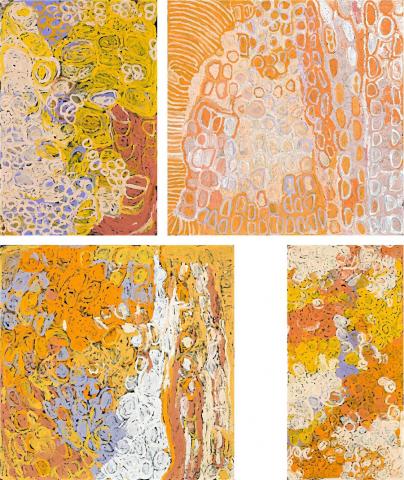(i) TWO WOMEN'S TRAVELS TO THE SITE SOUTH OF LAKE MACDONALD, 1998; (ii) TWO WOMEN'S DIGGING FOR WESTERN QUOLL IN THE LAKE MACDONALD AREA, 1998; (iii) TWO WOMEN'S DIGGING FOR WESTERN QUOLL IN THE LAKE MACDONALD AREA, 1998; (iv) TRAVELS OF KUNGKA KUTJARRA
MAKINTI NAPANANGKA
synthetic polymer paint on linen
91.0 x 61.0 cm; 91.0 x 46.0 cm; two panels 91.0 x 91.0 cm
inscribed verso: artist's name, size and Papunya Tula Artists cat. MN980440; MN9804175; MN980584; MN200004116
Papunya Tula Artists, Alice Springs
Gallery Gabrielle Pizzi, Melbourne
Private collection, Melbourne
Aborigena: Arte Australiana Contemporanea, Palzzo Bricherasio, Torino, 29 June – 26 August 2001
Bonito Olivia, A., Aborigena: Arte Australiana Contemporanea, Electra, Milano, Italy, 2001, p. 61 (illus.)
These works are accompanied by certificates of authenticity from Papunya Tula Artists.
Makinti Napanangka first came to prominence working on the collaborative Haasts Bluff / Kintore women's painting project, a series of major paintings, completed in 1994 and exhibited at the Tandanya National Aboriginal Cultural Institute in Adelaide, marked the beginning of Pintupi women's participation in the Western Desert art movement as independent artists. Up until then, women had largely worked as collaborators on paintings by their husbands and other close male relatives. Napanangka joined Papunya Tula Artists in 1996.1
Napanangka led a traditional bush life in their desert homelands until their first contact with white Australians as young adults. With the establishment of the outstation movement, Napanangka returned to live close to her country at Walungurru (Kintore), a small Aboriginal community more than 500 kilometres west of Mparntwe (Alice Springs).
Napanangka's work was included in the major retrospective 'Papunya Tula: Genesis and Genius' at the Art Gallery of New South Wales, Sydney, in 2000 and the Clemenger Contemporary Art Award at the National Gallery of Victoria in 2003 and solo exhibitions of her paintings were held at Utopia Artists, Sydney in 2000 and Gallery Gabrielle Pizzi, Melbourne in 2003.
This suite of four paintings depicts designs associated with the travels of the Kungka Kutjarra (Two Ancestral Women). During ancestral times a group of women visited this site, holding ceremonies associated with the area before continuing their travels north to Kaakuratintja (Lake MacDonald) and later the Kintore area. While at the site, the two women were digging for the small animal Kuningka (Western Quoll). These animals usually live in burrows dug by other animals such as the burrowing Bettong or rabbits. The lines in the painting represent spun hair-string which is used for making nyimparra (hair-belts), which are worn by both men and women during ceremonies.
1. Perkins, H. Tradition today: Indigenous art in Australia, Art Gallery of New South Wales, Sydney, 2004, p. 98
